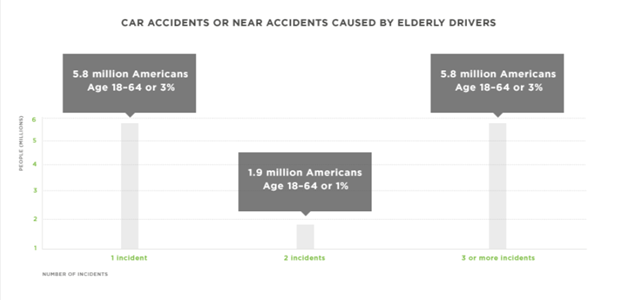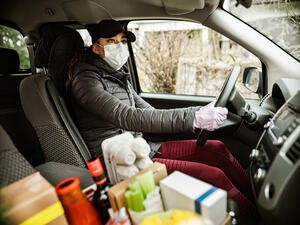by Flagship Staff | Mar 17, 2021 | Blog
As we transition from winter to spring, you may encounter fog on your daily commute or while running errands. Fog occurs when Mother Nature mixes cold air and warm air, causing water droplets or ice crystals to float in the air. Depending on where you live and other factors you may experience it more frequently than others.
Whether you’re a seasoned veteran behind the wheel or a new driver, encountering fog can be stressful. For me, it’s always a strange feeling when I’m on a familiar road, but the fog is so thick I have no idea where I am.
Here are some tips to keep you and your family safe the next time you encounter fog on your journey.
1. Reduce your speed. If you’re driving in fog it’s critical you slow down. Fog can reduce visibility so much that you can’t see what’s ahead, reducing your reaction time. Also, always keep an eye on your speedometer. Fog can cause disorientation when it comes to location and speed.
2. Watch the white line. Use the white painted line on the right side of the road as a guide for proper lane positioning. In addition, watch for other roadside indicators such as reflectors and signage.
3.Rely on your car’s low beam headlights. If driving in fog at night, low beams and fog lights provide the best visibility. If you’re like me, after driving in fog for a while you may doubt yourself and flip on your high beams only to quickly realize they don’t help. Remember to turn on your headlights if you’re driving in daytime fog.
4. Relax. Staying calm is important when driving in fog. If there’s a car in front of you, be patient. Road rage won’t do anybody a bit of good and could have severe consequences.
5. Don’t make unnecessary lane changes. Because fog is disorientating, staying in your current lane of traffic is your safest bet. Weaving in and out can be dangerous. If there’s an obstruction in the roadway try and slow down significantly, then check blind spots before moving over.
6. Turn on your defroster. Maximum visibility is key when driving in poor weather. Using your defroster can keep your windows clear of internal fog. You don’t need it inside and outside. Don’t forget to turn on your windshield wipers as well.
7. Don’t use cruise control. Like many other weather conditions, using cruise control in fog is dangerous. You simply don’t know what’s ahead. The last thing you need is for cruise control to increase your speed as your going up a hill.
8. Apply gentle inputs. When it comes to steering and braking, small inputs can be safer and more effective in keeping your car under control. Drastic movements can cause your car to perform unfavorably and dangerously.
9. Watch for animals. Just like us, animals, such as deer, can become disorientated and end up in the road in front of you. If this happens, apply significant pressure to your brake pedal. While your instinct may be to swerve, don’t do it. Swerving can put you in a more dangerous situation.
10. Use your hazard lights. If you’re like me, when it’s time to use them you have a challenging time finding the button. There are several important reasons to use your hazard lights. First, they provide more visibility to the cars approaching from the rear. In addition, they can alert other drivers that there’s a reason to be cautious and to slow down. Lastly, if you must pull over on the side of the road it’s critical to turn them on so others can see you. Remember we’re all struggling with visibility.
Do you have any tips you’d like to share? I’d love to hear your thoughts; please share them in the box below.
Topics: Auto Safety, Weather

by Flagship Staff | Mar 9, 2021 | Blog
According to statistics from the Federal Highway Administration, about 29 million Americans of the age 70 years or more are licensed drivers. In other words, one in six drivers in the U.S. belongs to the aging baby boomer population.
With increasing numbers of senior drivers on the roads, safety is a point of concern. This recent data suggests that in 2018 alone, almost 7,700 Americans lost their lives in car crashes involving an elderly driver.

Source
The good news is that seniors are reported to follow safety precautions while driving better than any other age group. From using seat belts to keeping speed limits in check, seniors are known to exhibit safe driving behaviors.
Driving is good for seniors too! It helps them stay fit, independent, and connected with their loved ones. However, driving is a complex task that requires healthy cognition and good flexibility.
If you or your senior loved one is planning to hit the road, we have a few tips that can lead to an enjoyable and safe long drive.
1. Plan Well. Once you decide on a destination, work on a detailed itinerary. Include your friends and family in the discussion. They can offer valuable advice to help you determine the best route possible.
Next, pick up a map or choose from a bunch of apps that could prove handy during the planning process. Remember to take a printout of the route for areas where your network may falter.
Tell your neighbors (and pet sitters if you’re planning to leave pets behind) of your returning date. Share your emergency contact details too.
2. Evaluate Your Health Condition. According to this report, long-distance travelers are prone to severe health conditions. The risk increases for seniors. If you’re battling a chronic age-related health condition like hypertension or diabetes, it’s wise to get yourself thoroughly examined before embarking upon the journey. A thorough checkup of your eyesight, hearing, and other senses is highly recommended.
During the drive, remember to take frequent breaks. According to this survey, drowsy driving is a major cause of fatalities. On the road, it’s wise to take short breaks at regular intervals to stretch or walk around.
Also, make sure you get adequate sleep. It’s recommended that people of 65 years and above get at least seven to eight hours of sleep per day.
3. Make Safety a Priority. Obviously, road safety is of prime importance, especially for seniors going on long drives. Honoring your driving limitations and being attentive while parking can make your journey a lot safer.
Here are a few quick tips to stay safe while on the road:
As mentioned earlier, rest before heading out for your long drive. Don’t drive if you have just taken a medication that induces drowsiness.
Address your driving limitations. For instance, if you’re having issues with visibility, avoid driving at night. Plan your trip accordingly.
Take a defensive approach while on the road. For instance, maintain a safe distance from the car in front of you, avoid mobile phone distractions, and stay mindful at intersections.
Get your vehicle checked thoroughly for fluid levels and tire pressure. It’s wise to involve an expert for this.
4. Stock Up on Medications. According to a recent pre-pandemic survey, road travel is a top priority among 37 percent of the senior population. But seniors are often taking medications that may not be available everywhere. Hence, it’s wise to stock up on prescribed medications.
The rule of thumb is to get a 90-day supply. Keep a copy of your prescription handy during the trip. Make sure you carry medications in their original labeled containers to avoid any confusion.
5. Take Your Pets Along. What better company can you expect on long drives other than your furry friends? Your mutt will not just be your constant travel companion but could offer a sense of security while you’re on the go.
Remember to take their comfort into account during the trip. Look for pet-friendly lodging through the course of your journey.
Also, exercise all precautions to keep your pet safe and healthy. For instance, make sure that your pets have access to air conditioning, especially during warm-weather travel. Pack lots of fresh water for both yourself and your furry friends, and never leave your pets alone in the car.
6. Pack Smartly. Remember to pack all the essentials for your trip. Start with preparing an emergency kit that includes a first aid kit, healthy snacks, and bottled water.
Also, carry your health insurance cards, medical bracelets, and as mentioned earlier, prescriptions. Consider putting an index card in your wallet filled with relevant medical and contact information. If it happens to land in a stranger’s hands, it could help provide you with the proper roadside assistance.
Long road trips are fun. They can help you enjoy retrospection, tackle stress levels, and offer a sense of independence in your golden years. Use the tips shared here to keep safe and enjoy your long road trip!
Author Bio: Jeff Hoyt works as the Editor-in-Chief at SeniorLiving. He writes articles that inspire seniors to live better lives independently. Many of his articles have been republished on websites like MSN, AOL, Yahoo, Fox News, and HuffPost, while Reader’s Digest has named him a financial expert. He’s also a member of the Writers Guild of America and Phi Beta Kappa and has been nominated for an Emmy award. Enjoy his Senior Living YouTube videos.
Topics: Auto Safety, Travel
by Flagship Staff | Mar 2, 2021 | Blog
If you’ve remodeled your home, you know how messy drywall dust can be. Clouds of fine dust can linger in your home and cause cleanup to last weeks after your project is complete.
Currently, my basement is under construction, and we’re at the drywall stage. To say it’s messy is an understatement. Frequently, I’m downstairs sweeping and vacuuming the dust. While this doesn’t eliminate it completely, it does help keep it a bit under control.
Here are some tips that can help you through your remodeling project.
1. Create a plan. Before tearing down your walls, make sure you have a plan. While a “do-it-yourself” project may seem like a good idea, there are many things to consider. Depending on your project, you may need to obtain permits from your city’s inspection department. In addition, when talking with them, they may be able to offer you some project tips.
2. Hang plastic sheeting. Plastic sheeting does a good job keeping the dirt and dust in the work area. It also works well for creating walls to protect other areas of your home. We used it to protect our storage area as well as the area where our water heater and furnace are located. Doing this really minimized the amount of dust in these areas.
3. Turn off your HVAC system. Depending on the time of year, this may be a bit tough. However, turning off the system can help prevent sending dust throughout your home. If you’re remodeling during the winter months, consider using alternative heat sources, such as a fireplace or electric heater. After you’ve cleaned the work site and removed as much dust and debris as possible, you can turn it back on.
4. Seal your vents. To protect your HVAC system and to limit the dust from circulating in the air in your home, seal the vents in the work area. Depending on where you’re working, there may be two types of vents that need to be covered. Registers may be in your floor or ceiling and have the primary job of blowing out the air which keeps your home cool or warm. Returns or intakes suck the air into your HVAC system. Before sealing them off, make sure you’re aware of their function. You may need to unseal them before turning your system back on. To run efficiently your furnace needs air. The last thing you want to do is damage it.
5. Buy some box fans. Again, depending on the season this may also be challenging. However, putting box fans in several windows throughout your home can help remove the dust. Even though we’re experiencing extreme cold right now, I have a fan in my basement window to remove some of the dust. If it’s winter, I’d recommend constantly monitoring the inside temperature. You don’t want your home to get below 55 degrees Fahrenheit.
6. Clean, clean, clean. While thoroughly cleaning your work area each day can be a nuisance, it’s a good way to mitigate the amount of dust. I’ve found that using a push broom doesn’t work well. It seems to stir up the dust more than anything. Therefore, I gently use a regular broom followed by my Shop-Vac®. If you decide to follow this approach, the air filter in your vacuum will need to be cleaned frequently. If you notice loss of suction, it’s time for a cleaning. Unfortunately, drywall dust can clog it up quickly. In addition, cleaning the rest of your home more regularly during the project can help. It’s amazing how fast dust accumulates.
7. Keep an eye on your furnace filter. The purpose of your furnace filter is to trap dust and debris, preventing it from traveling throughout your home. During a project, especially one involving drywall, the dust in the air can be terrible. Clean your filter regularly to prevent blocked airflow as well as the dust from overwhelming your furnace and home. At the end of your project, you’ll want to buy a new one.
8. Buy an air purifier or humidifier. The job of an air purifier is to clean the air we breathe. It can remove pollutants, allergens, and toxins. While a humidifier can add particles to the air; keeping your home’s humidity at the proper level can help. Moist air is heavier than dry air which prevents the dust and other particles from freely floating around in your home.
9. Protect your flooring. There are many products available that can provide protection. Where your project takes place can dictate what type of covering to use. We put down a plastic barrier with an adhesive backing on the stairs leading to the basement. If you have hardwood floors or ceramic tile, you’ll want to use something heavier, such as cardboard. The last thing you want is a dropped hammer denting or cracking your flooring.
10. Develop a plan for sanding. After your mud and tape on your drywall has cured, it’s time to sand. Using a manual sanding pad or an electric sander can create a dust storm in your home. Depending on the size of your project, there may be some alternatives available. The method I used was wet sanding. While it may not do as good of a job, it does help keep the dust down. A damp sponge can smear the drywall compound and make your surface smooth. While it’s a bit more time consuming, I think it’s worth it. Plus, if you’re applying knockdown texture to your wall, that can help hide some imperfections.
I hope you found these tips helpful and your project goes well!
Topics: Home Safety

by Flagship Staff | Feb 25, 2021 | Blog
If you use your personal vehicle for deliveries, will you get a generous tip or a substantial bill for your damaged vehicle?
In the current world of social distancing and self-quarantining, delivery app services are in high demand. If you decided to supplement your income by becoming a delivery driver, do you and your car have insurance coverage if you have an accident while you’re making a delivery?
Here are a few tips to help prevent paying out of pocket if you have an auto accident while making deliveries.
1. Don’t assume personal auto insurance automatically provides coverage.
a. Some insurance carriers do permit their policyholders to deliver food but it’s usually only if they’re employed by one eatery. Most standard personal auto and umbrella policies include exclusionary language against delivery of goods or persons for public delivery app services like Uber Eats, GrubHub, and DoorDash. The exclusion language usually references an auto being held out to the public as a means of transportation (of people or property) for which the driver/policyholder will be paid for that transportation. This includes, but is not limited to, any period of time the driver is logged into a transportation network platform, whether or not a passenger or meal is being transported in the vehicle at the time of the accident.
2. Call your insurance agent. Let them know you’re using your vehicle to make deliveries. Ask your agent if your current auto insurance covers your delivery exposure. If it doesn’t, find out if delivery coverage can be added to your policy.
3. Contact your delivery app company. Find out what insurance coverage is required and if they offer insurance coverage. But be careful! Some delivery apps will provide coverage only if you have food in your car but not while driving to the restaurant. Also, in the event of a loss, some delivery app companies will only “pay in excess.” This means your own underlying insurance policy will have to respond to a claim before the delivery app company’s excess/secondary policy responds.
4. Inquire about a commercial auto insurance policy. Call your insurance agent about a commercial auto policy If you feel you’re not covered adequately under your personal auto insurance policy or with your delivery app company.
So, before you hop into your car to make that next delivery, be sure to call your insurance agent to make sure you and your vehicle are protected!
Do you have any tips or information you’d like to share? I’d love to hear them; please share them in the box below.
This blog was written by Wendy Wagner, Personal Lines underwriter.
Topics: Auto Insurance

by Flagship Staff | Feb 18, 2021 | Blog
The change in how we do business across the nation and the world, has allowed for businesses run out of private homes to become a commonplace occurrence versus an exception.
Companies have realized that a brick-and-mortar facility isn’t always needed to operate their business effectively and efficiently. If you’re one of the many people who’ve converted your basement into your shop or are now calling your dining room your new workspace, you may have some questions about your new working environment.
Does your homeowners insurance provide coverage for your business needs? Or do you still need to keep in force your business insurance policy? What equipment is covered and what’s not covered? If you’re working remote and get hurt during business hours is it covered by your employer’s workers’ compensation policy?
Does your homeowners insurance provide coverage for your business?
Homeowners insurance isn’t business insurance, so business owners need to understand their homeowners insurance policy may not provide all the coverage they need. A business owner needs to consider the following when determining which types of coverage are necessary:
- Business Personal Property – What limits do you need? Can your homeowners insurance policy be endorsed to include adequate coverage?
- Liability – Is there coverage if a customer slips and falls, injuring themselves while visiting your home? If your business makes crafts, is there products completed coverage?
- Auto insurance – If you’re using your personally owned auto for business needs, is there coverage provided from your personal auto insurance policy?
- Business income – If your home burns down and it causes your business to pause operations, is there coverage?
It’s imperative policyholders check their homeowners insurance policy to verify if there’s adequate coverage, or they should discuss adding coverage with their independent agent.
Does your homeowners insurance provide coverage if you’re an employee working remotely?
Many employees today have found working from home can be just as productive as working from the office. But there are some questions that need to be answered to make sure there are no coverage gaps between what your homeowners insurance policy provides and what’s covered under your employer’s business policy.
- Who provides coverage for the laptop you use for work? What about other equipment such as printers, cell phone, or iPad?
- What if you get injured while working at home? Are you covered under your employer’s workers’ compensation policy, or are you covered under your homeowners insurance policy?
- What if you’re working from a remote place other than your home?
- What if you use your personal auto for business purposes? Where’s the coverage being provided?
To gain a more thorough understanding of what insurance coverage is provided by your employer, you should contact your human resources department. To understand what your homeowners insurance policy covers, contact your independent insurance agent.




